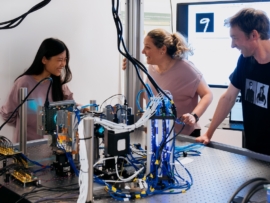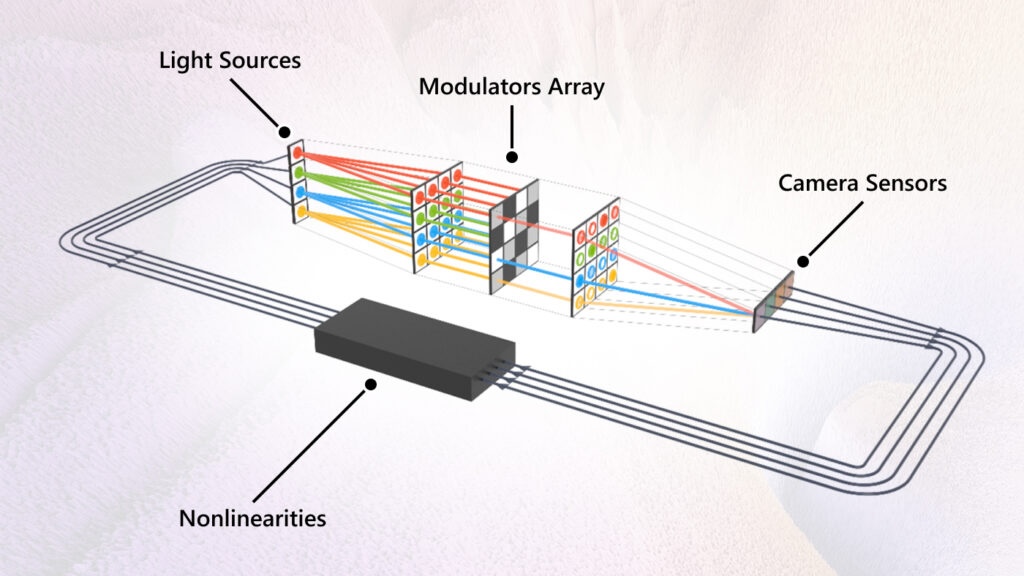
A Microsoft Research team has published results of their work developing an analog optical computer (AOC) that could run large language models more efficiently. The experimental computer also excels at certain math problems.
The team, comprising experts from various disciplines, has been working on the analog optical computer for four years as part of Microsoft’s broader Future AI Infrastructure project. The initiative seeks to develop new hardware for AI and cloud data centers.
Two results of the analog optical computer experiment were detailed on Sept. 3: an optimization solver algorithm and the analog digital twin.
“We have actually delivered on the hard promise that it can make a big difference in two real-world problems in two domains, banking and healthcare,” said Hitesh Ballani, researcher in future AI infrastructure at the Microsoft Research lab in Cambridge, UK, in a press release. “We opened up a whole new application domain by showing that exactly the same hardware could serve AI models, too.”
Analog optical computer can be used in finance or medicine
Microsoft researchers began building the analog optical computer four years ago. Optical cables have been used to transmit data for 50 years, but the Microsoft project increases the number of parameters or weights from 64 to 256.
The optimization solver algorithm can be used to solve a persistent problem in banking. Barclays Bank PLC researched using it to solve complex delivery-versus-payment securities problems. It solved a transaction settlement problem that had up to 1,800 hypothetical parties and 28,000 transactions, just a fraction of the transactions that typically pass through a clearinghouse between banks and other financial institutions.
An algorithm running on the AOC can also be deployed to speed up MRI scans from 30 minutes to five minutes.
“To be transparent, it’s not something we can go and use clinically right now,” said Michael Hansen, senior director of biomedical signal processing at Microsoft Health Futures, in the press release. “Because it’s just this little small problem that we ran, but it gives you that little spark that says, ‘Oh boy! If this instrument was actually in full scale’ …”
Microsoft Health Futures utilised a digital twin of the AOC to demonstrate the viability of the machine and scale it up to address larger problems than the actual instrument is capable of handling.
The AOC is “not a general purpose computer, but what we believe is that we can find a wide range of applications and real-world problems where the computer can be extremely successful,” said Francesca Parmigiani, a Microsoft principal research manager and head of the team developing the AOC.
LLM reasoning could be performed at a lower energy cost
The AOC could potentially run one type of LLM reasoning – state tracking – at a lower energy cost than performing the same reasoning on GPUs. The AOC can perform it at a lower cost in energy because of the way it calculates, repeatedly trying to solve a problem in search of a “fixed point” to end on.
How does the analog optical computer work?
The AOC works by making computations based on varying intensities of light moving through a digital sensor.

Specifically, the Microsoft researchers built projectors with optical lenses, digital sensors, and micro-LEDs. They aimed to use commercially available components, such as sensors from smartphone cameras, to keep the price down and ensure the AOC could be manufactured within the existing supply chain.
The Microsoft Research team anticipates building a new generation of the AOC every two years.
“To have the kind of success we are dreaming about, we need other researchers to be experimenting and thinking about how this hardware can be used,” Parmigiani said.
The team has published a paper on their findings in the journal Nature and released a repository for the digital twin of the AOC on GitHub.
Microsoft says its August security update did not cause widespread data corruption and hardware failure in solid-state drives.
Source of Article



